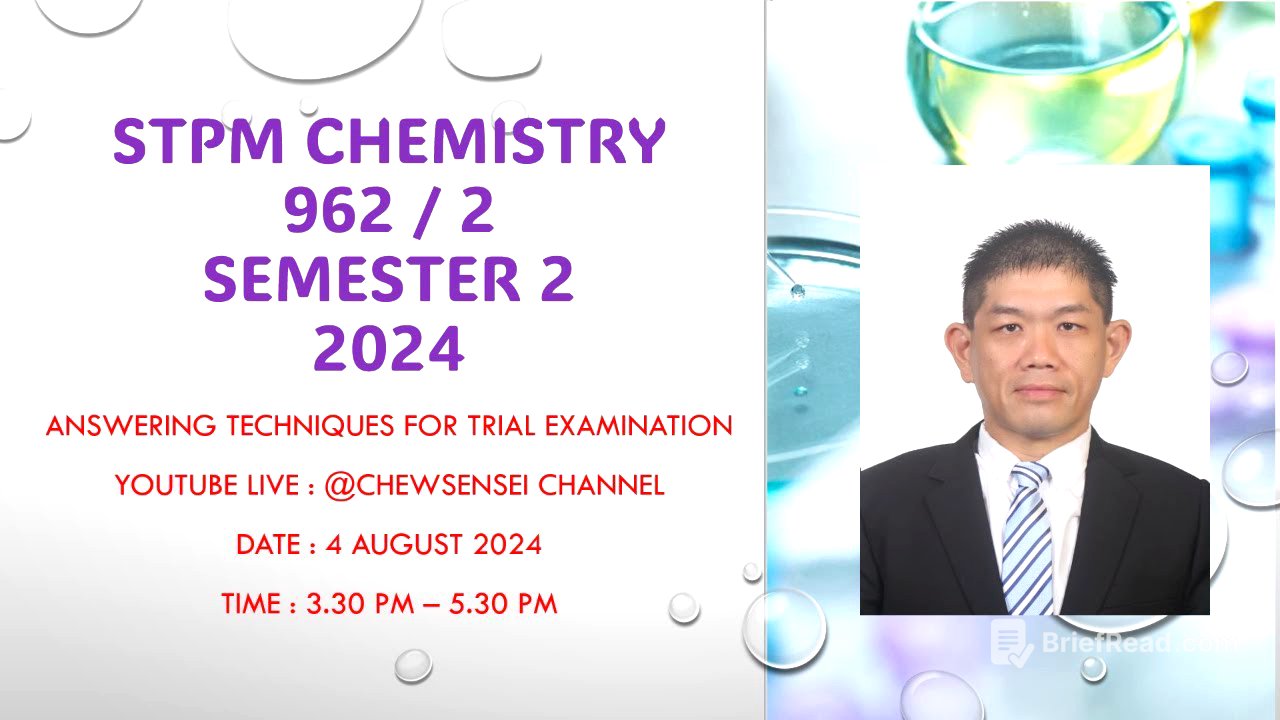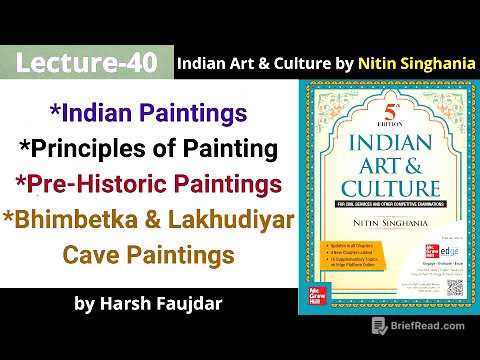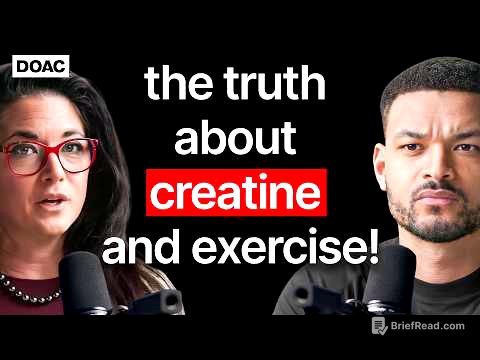TLDR;
This video by Chew Sensei provides a detailed walkthrough of answering techniques for STPM Semester 2 Chemistry, focusing on time management, understanding key concepts, and effective study strategies. The session includes a review of the scheme of assessment, tips for creating short notes, the importance of past year papers, and group study benefits. The bulk of the video is dedicated to discussing and solving past year questions from Section A (objective questions), along with explanations and problem-solving strategies for structure and essay questions.
- Time management is crucial for STPM success.
- Short notes and group studies are effective learning methods.
- Familiarity with past year questions is essential.
- Understanding key concepts is vital for answering effectively.
Introduction [0:09]
Chew Sensei welcomes everyone to the session, expressing hope that attendees have had lunch and are ready to discuss answering techniques for Semester 2. He confirms that the presentation slides are visible and introduces himself for those who may not know him from Semester 1.
Self Introduction [2:02]
Mr. Chu shares his background, mentioning he is 43 years old and has been teaching at INTI College Johor Bahru for 21 years. He notes his experience as a former national trainer and author of guidebooks, advising students to seek original copies from him or their teachers rather than purchasing potentially unauthorized versions online.
Scheme of Assessment [3:43]
The session will cover the scheme of assessment, emphasizing the importance of time management for the 15 objective, two structure, and two essay questions. Mr. Chu aims to share his experience to help students answer effectively and quickly, highlighting that many students struggle with time management.
Preparation Tips [5:30]
Students are advised to read in detail, create short notes based on their understanding, and verify information with teachers, reference books, or online sources. Mr. Chu mentions providing short notes and encourages students to use past year papers (22 sets from 2013-2023) and study in groups to enhance understanding.
Section A: Objective Questions - Question 1 [9:19]
The discussion begins with Section A, where all questions must be answered. Question 1 involves identifying exothermic reactions from a list of chemical equations. The correct answer is C, as reactions 1 (formation/combustion of MgO) and 3 (hydration of Mg2+) are exothermic. Students need to memorize the 10 enthalpy changes to answer effectively.
Section A: Objective Questions - Question 2 [11:31]
Question 2 focuses on nitrogen monoxide formation and bond energy calculations. By analyzing the provided information and applying enthalpy of atomization concepts, the correct answer is C, indicating that N≡O has a stronger covalent bond. The structure of nitrogen monoxide is also discussed, highlighting its triple bond.
Section A: Objective Questions - Question 3 [14:52]
Question 3 involves a Born-Haber cycle for barium oxide. Using the enthalpy change of formation and Hess's Law, the value of x is calculated to be positive 751 kJ/mol, making the answer C.
Section A: Objective Questions - Question 4 [17:45]
Question 4 requires identifying which reactant pairs do not undergo spontaneous redox reactions under standard conditions. The correct answer is A, as MnO4- and Cl2 are both on the left-hand side of the given equations, indicating no redox reaction.
Section A: Objective Questions - Question 5 [21:28]
Question 5 involves an electrochemical cell with a standard hydrogen electrode and a magnesium electrode. By using the Nernst equation, it's determined that option D is incorrect, making it the answer.
Section A: Objective Questions - Question 6 [27:07]
Question 6 deals with electrolysis in a series of electrolytic cells. The mass of the gaseous product formed at the anode is calculated. The correct answer is D (3.93), involving the electrolysis of water.
Section A: Objective Questions - Question 7 [32:43]
Question 7 asks about the diaphragm cell used to electrolyze brine. The correct answer is A, stating that the liquid level in the anode compartment must be higher than in the cathode to prevent back pressure.
Section A: Objective Questions - Question 8 [34:39]
Question 8 involves interpreting a graph of a physical property against the proton number of period three elements. The property is identified as first ionization energy.
Section A: Objective Questions - Question 9 [35:57]
Question 9 concerns the decomposition temperatures of magnesium and calcium carbonates. The best explanation for the difference is B, stating that Mg ion has a higher polarizing power.
Section A: Objective Questions - Question 10 [39:16]
Question 10 addresses the diagonal relationship between beryllium and aluminum. The correct statement is B, noting that beryllium chloride and aluminum chloride form dimeric gaseous species.
Section A: Objective Questions - Question 11 [41:33]
Question 11 focuses on the inert pair effect in lead. The true statement is D, indicating that lead(IV) oxide decomposes to lead(II) oxide when heated strongly.
Section A: Objective Questions - Question 12 [43:07]
Question 12 asks about borosilicate glass. The correct answer is A, stating that it is resistant to thermal shock.
Section A: Objective Questions - Question 13 [44:20]
Question 13 concerns the reaction of chlorine with aqueous sodium hydroxide under different conditions. The true statement is C, indicating that the oxidation states of chlorine after the reaction are -1 and +5.
Section A: Objective Questions - Question 14 [45:46]
Question 14 involves the reaction of potassium thiocyanate with iron(III) sulfate. The correct statement is C, noting that the blood-red solution is due to the formation of a complex with a coordination number of six.
Section A: Objective Questions - Question 15 [47:31]
Question 15 asks for the reason platinum is used as a catalyst for the hydrogenation of alkenes. The answer is A, because platinum has d orbitals to form a temporary chemical bond.
Section B: Structure Questions - Question 16 [50:16]
Question 16 focuses on disulfur difluoride (S2F2). It covers writing thermochemical equations for enthalpy change of formation and atomization, calculating the standard enthalpy change of formation using Hess's Law (-204 kJ/mol), and constructing an energy level diagram.
Section B: Structure Questions - Question 17 [1:08:27]
Question 17 discusses collinite, a hydrated alumino-silicate mineral. It includes determining the oxidation number of silicon (+4), explaining why basic clay is unsuitable for most plants, suggesting uses of collinite, and describing the repeating unit of silicate sheets (Si2O52-) along with a physical property (electrical neutrality or slipperiness).
Section C: Essay Questions - Question 18 [1:15:37]
Question 18 involves an electrochemical cell. It covers drawing and labeling a diagram of the chemical cell, calculating the E° value for the Sn4+/Sn2+ couple (+0.15 V), and calculating the concentration of sulfuric acid and the pH of the solution in the hydrogen half-cell (pH = 0.135). It also addresses predicting the spontaneity of the reaction between manganese(IV) oxide and hydrochloric acid under standard conditions (non-spontaneous).
Section C: Essay Questions - Question 19 [1:28:51]
Question 19 presents a hypothetical element, "My," and compares its properties to barium. It includes comparing and explaining the melting point and ionization energy of "My" with barium, explaining the reactivity of "My" with water and oxygen, and comparing the thermal stability of "My" nitrate with that of magnesium nitrate.
Section C: Essay Questions - Question 20 [1:36:40]
Question 20 discusses silver halides and their role in black and white photography. It covers identifying the solid halide (AgBr), explaining its role with suitable equations, stating what happens when silver halide is exposed to sunlight, and writing equations for the reactions that take place. It also addresses the reaction between chlorine and water, identifying the active ingredient for bleaching (HOCl), and calculating the volume of sodium hydroxide solution needed to neutralize a solution containing chlorine.









